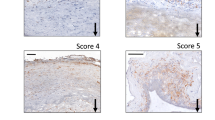Summary
The material studied consists of 10 cases of intracranial saccular aneurysms. Four came from autopsies, and in each of the other six aneurysmal wall was obtained at surgery after clipping of the aneurysm. The most significant findings from this pathological study are the almost complete disappearance of the internal elastic lamina at the level of the aneurysmal neck, sclerosis of the muscle coat, and in satellite vessels and vasa vasorum disruption of the internal elastic lamina and partial luminal occlusion. The importance of ischaemic changes in the aneurysmal wall is discussed. Rupture of the aneurysm at the distal extremity of the sac depends probably on the progressive brittleness of its wall which becomes sclerotic and less resistant to the blood pressure within. Splitting or rupture of the aneurysm appears to be dependent on degenerative ischaemic alterations in its wall.
Similar content being viewed by others
References
Carmichael, R., The pathogenesis of non-inflammatory cerebral aneurysms. J. Path. Bact.,62 (1950), 1–19.
Fergusson, G. G., Turbulence in human intracranial saccular aneurysms. J. Neurosurg.33 (1970), 485–497.
Forbus, W. D., On the origin of miliary aneurysms of the superficial cerebral arteries. Johns. Hopk. Hosp. Bull.47 (1930), 239–284.
Frugoni, P., Le emorragie sottoarachnoideali cosiddette spontanee: loro significato e possibilità terapeutiche. Estratto Boll. Accad. Med. Pistoiese: “F. Pacini”. Anno XXIX, 1958.
Fry, D. L., Acute vascular endothelial changes associated with increased blood velocity gradients. Circ. Res.22 (1968), 165–197.
Lang, E. R., Kidd, M., Electron microscopy of human cerebral aneurysms. J. Neurosurg.22 (1965), 554–572.
McDonald, C. A., Korb, M., Intracranial aneurysms. Arch. Neurol. Psychiat.42 (1939), 298–328.
Morgagni, G. B., De sedibus et causis morborum. Venetiis ex. typog. Remondiniana, Livre I, lettre 4, cas. 19 (1761).
Nystrom, S. H. M., Development of intracranial aneurysms as revealed by electron microscopy. J. Neurosurg.20 (1963), 329–337.
— Cytological aspects of the pathogenesis of intracranial aneurysms. In: Intracranial aneurysms and subarachnoid hemorrhage, pp. 40–69 (Field, W. S., Sahs, A. L., Eds.). Springfield, Ill.: Ch. C Thomas. 1965.
Padget, D. H., The circle of Willis, its embryology and anatomy. In: Intracranial aneurysms, pp. 67–90. New York: Comstock Publisher Co. 1944.
Stehbens, W. E., Histopathology of cerebral aneurysms. Arch. Neurol.8 (1963), 272–285.
—, Ultrastructure of aneurysms. Arch. Neurol.32 (1975), 798–807.
Yaşargil, M. G., Fox, J. L., Ray, M. W., The operative approach to aneurysms of the anterior communicating artery. In: Advances and Technical Standards in Neurosurgery, pp. 115–170, Vol.2 (Krayenbühl, H., Ed.). Wien-New York: Springer. 1975.
Author information
Authors and Affiliations
Rights and permissions
About this article
Cite this article
Scanarini, M., Mingrino, S., Giordano, R. et al. Histological and ultrastructural study of intracranial saccular aneurysmal wall. Acta neurochir 43, 171–182 (1978). https://doi.org/10.1007/BF01587953
Issue Date:
DOI: https://doi.org/10.1007/BF01587953




